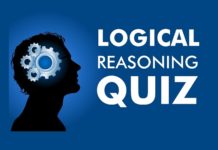REASONING QUIZ
(Q.1) A is mother of B, who is sister of C. D is father of C. A is sister of M. D has only one son. How is C related to M?
(a) Niece
(b) Nephew
(c) Son
(d) Cannot be determined
(e) None of these
(Q.2) M is married to L, who has only two sons K and J. R is the only daughter of S who is married to K. How is R related to M?
(a) Grandson
(b) Cannot be determined
(c) Granddaughter
(d) Grandmother
(e) None of these
(Q.3) N’s father is brother of J’s mother, who is married to L. How is L related to N?
(a) Uncle
(b) Aunt
(c) Paternal Uncle
(d) Cannot be determined
(e) None of these
(Q.4) Pointing to a photograph, Kumar said “She is the sister of my Paternal grandmother’s only son”, how is the girl in the photograph related to kumar?
(a) Uncle
(b) Aunt
(c) Sister
(d) Cannot be determined
(e) None of these
(Q.5) A%B means A is father of B, A&B means A is mother of B, A*B means A is daughter of B. In this expression ‘P%Q&R*T’ how is P related to T?
(a) Mother
(b) Brother
(c) Sister
(d) Father-in-law
(e) None of these
(Q.6) A is mother of C, who is daughter of B. D is father of R and married to C. How is C related to R?
(a) Daughter
(b) Sister
(c) Daughter in law
(d) Cannot be determined
(e) None of these
Study the following information and answer the questions given below:
W, E, R, T, Y, U, M and P are there in the family. There are three married couples in the family. W is married to E, who has only two daughters U and P. T is father of M, who is brother of Y. P and R are married couples and has no children.
(Q.7) If W is mother in law of T, then how E is related to Y?
(a) Grand Mother
(b) Grand Son
(c) Grand daughter
(d) Grandfather
(e) None of these
Q (8-10) Study the following information and answer the questions given below:
W, E, R, T, Y, U, M and P are there in the family. There are three married couples in the family. W is married to E, who has only two daughters U and P. T is father of M, who is brother of Y. P and R are married couples and has no children.
(Q.8) How is T related to R?
(a) Sister in law
(b) Sister
(c) Sister in law’s husband
(d) Cannot be determined
(e) None of these
(Q.9) If Y is granddaughter of W, then how is Y related to P?
(a) Niece
(b) Nephew
(c) Son
(d) Daughter
(e) None of these
(Q.10) If M is married to H, then how is Y related to H?
(a) Sister in law
(b) Brother in law
(c) Sister
(d) Cannot be determined
(e) None of these
(D.11-15) Study the following information carefully and answer the given questions.
Eight persons A, B, C, D, E, F, G and H are sitting around a circular table facing inside the center. Each person likes different subject viz. Chemistry, Biology, Geography, Civics, Economics, English, Physics and Mathematics. C sits third to the right of A. One person sits between C and one who likes English. Three persons sit between B and F. One who likes English and one likes Economics are immediate neighbours. H likes Mathematics and sits third to the right of one who likes Economics. B sits immediate left of C. One who likes Biology sits between one who likes Chemistry and Geography. One who likes Physics and one who likes Geography are facing each other. E sits third to the left of G. G and one who likes Physics are immediate neighbours.
(Q.11) Who among the following persons sits second to the right of G?
a) B
b) C
c) A
d) H
e) None of these
(Q.12) Who among the following persons sits exactly between E and B when counted from left of B?
a) C
b) G
c) A
d) D
e) None of these
(Q.13) Which of the following combinations is true?
a) E – Chemistry
b) C – Physics
c) F – Economics
d) G – Biology
e) None of these
(Q.14) Who among the following persons likes Civics?
a) C
b) A
c) D
d) G
e) None of these
(Q.15) Which of the following statements is true?
a) H sits opposite to E
b) C likes Chemistry
c) F and A are immediate neighbours
d) Two persons sit between A and E
e) None is true
(D.16-20)Study the following information carefully and answer the questions given below.
Eight persons G, H, I, J, K, L, M and N are standing in a row. Some of them face north and some of them face south but not necessarily in the same order. G and H do not face same direction. Not more than two person are standing together do not face same direction. Three persons are standing between K and I, both of them do not face same direction. G is not standing any of the extreme ends. Not more than four persons face south direction. Either K or I is standing at one of the extreme ends. Two persons are standing between L and M who is immediately next to I. L and M are facing the direction as I. J and N are immediately standing to each other and both of them do not face same direction. H is standing third to the left N. G is second to the left f H.
(Q.16) What is the position of G with respect to N?
a) Third to the right
b) Immediate right
c) Second to the left
d) Fourth to the right
e) Fifth to the left
(Q.17) Who among the following persons are immediately standing with L?
a) G and M
b) H and G
c) I and N
d) H and I
e) None of these
(Q.18) Who among the following persons are standing at the extreme ends?
a) K, H
b) I, J
c) H, I
d) K, J
e) None of these
(Q.19) How many Persons is/are standing between H and J?
a) Three
b) Four
c) Two
d) One
e) None
(Q.20) If all of them are standing in alphabetical order from right to left then, how many of them will remain unchanged?
a) One
b) Two
c) Three
d) Four
e) None
ANSWERS
1. B
2. C
3. A
4. B
5. E
6. E
7. D
8. C
9. A
10. D
11. D
12. B
13. C
14. D
15. E
16. E
17. B
18. D
19. A
20. E












